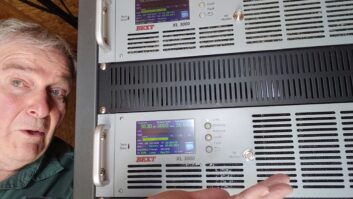Some people predicted an “IBOCalypse” when AM HD operations went full-time on Sept. 14. The band would drown in a sea of digital hash, digital doomsdayers warned.
It didn’t happen, at least not yet. But there is plenty to worry about on the AM IBOC front.
First, let’s all agree that not enough stations have been transmitting HD Radio at night to provide a realistic evaluation of the consequences. That argues for calm, although the low activation rate is itself also a measure of the problem; if the system met the needs of AM broadcasters they should be jumping on it.
Citadel Director of Corporate Engineering Martin Stabbert embodied questions about the efficacy of full-time AM HD when he ordered all his AMs that had already converted to cease transmitting HD at night, using language that must have given Ibiquity officials heartburn. Separately and for different immediate reasons, Cox, in a “let’s wait and see” move, has tried HD on most of its AM stations but is taking it off the air day and night, once tested at each facility.
So critics are ready to pounce, citing “early proof” that AM HD is in trouble.
It’s not as though no one saw this coming. The genesis of a rocky rollout for AM HD is grounded in the original imperative Project Acorn faced more than 15 years ago. Large group owners forced NAB’s hand to forget about Eureka-147 and urged development of an in-band solution as the only acceptable digital format for U.S. broadcasters.
But it had to include both the FM and the AM services. Ignoring the senior band in the pursuit of a digital transition was unacceptable (an argument in which we concur).
Yet the AM band already was compromised with overcrowded and overlapping channel allocations. Add the insult of skywave interference and even a non-technical observer understands that the laws of physics stacked the deck in this challenge.
Credit the genius of engineers who have made AM IBOC work at all; but they sculpted a model out of a flawed piece of spectrum. To achieve their ambitious goal, secondary coverage would have to be sacrificed.
Ibiquity and other advocates also may have underestimated the importance stations would give to maintaining their existing analog service areas. Certainly, few proponents seem to have taken seriously the vocal concerns of smaller AM stations that have been bubbling about for a long while. It’s not “just hobbyists and DXers” who have concerns, contrary to what some proponents say under their breath.
When a smaller-market station feels betrayed by the NAB and FCC, that’s a bad situation — and clearly, some do. Put yourself in a small AM manager’s shoes. Beyond the substantial investment required to add HD, one the station may not be able to afford, he or she perceives that the newly adopted standard could dramatically decrease their effective nighttime interference-free service area and cause the loss of valuable daytime fringe-area coverage.
Even a number of major-market stations that have deployed AM HD are feeling the pinch of reduced coverage at night. Those with strong adjacent-channel neighbors have had their nighttime service area coverage shrink substantially.
Owners like Clear Channel and CBS reportedly are having to choose which AM HD stations to leave on at night and which ones they’ll turn off due to interference inflicted on more important co-owned stations.
Don’t expect the FCC to come to the rescue. The commission seems content to let the marketplace decide this one. It will step in only to rule on interference cases where the adversaries cannot resolve the issue, though we’d prefer to see it take a more active role in facilitating solutions.
Some observers think the only way the situation will resolve itself is if the FCC is forced to decide the interference issues are serious enough to warrant rescinding all nighttime AM HD authority, or if the NAB and major group owners pressure Ibiquity to forge a modified digital modulation scheme that is more scalable and flexible — above all, one that produces less adjacent-channel interference.
Whether DRM or some new technology breakthrough would allow this, only time will tell. Unfortunately, if FM HD eventually does take hold and millions of HD Radios with the current AM HD standard are sold, the chances of that diminish; so the window of opportunity to fix this would be relatively short.
Others feel there is no window for change at all. Unless the “fix” is something that can be handled dynamically in code, receiver manufacturers aren’t going to back up and start over with a new or significantly modified platform for AM. Could OEMs abandon AM altogether instead?
We remain cautious supporters of IBOC and HD Radio. We believe it is an imperfect system that nevertheless has offered the radio industry what it asked for through its national management and engineering representatives: a way to transition voluntarily at a chosen pace to a digital future without giving up valuable spectrum.
But we hope Ibiquity and its partners don’t pooh-pooh this AM problem or let it become a marketing nightmare at a time when digital radio needs good headlines, not bad. Things could get ugly.
Ibiquity has been relatively quiet in public about the situation. What we need right now is a vocal response from the company saying “We recognize AM at night is an important issue to the U.S. radio industry, and we want to work with all broadcasters on a satisfactory solution.” We also need the engineers of stations involved in interference disputes to talk to each other and to consider this an industry challenge, one that is best solved through cooperation.
There aren’t any easy answers here. We hope and trust that Ibiquity’s technical experts and top management are working closely with their radio engineering customers to help forge a solution.
— RW












